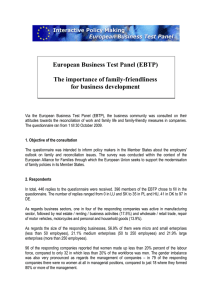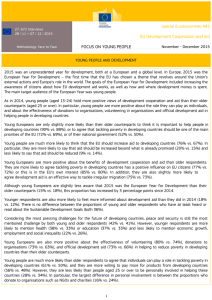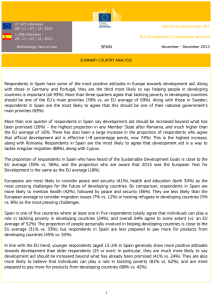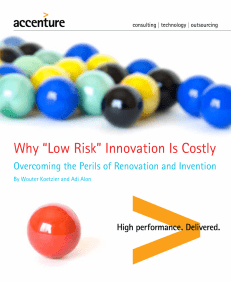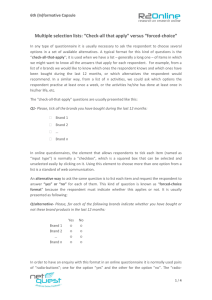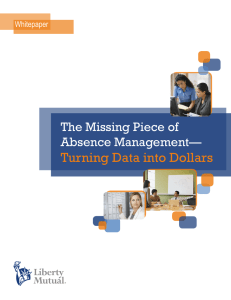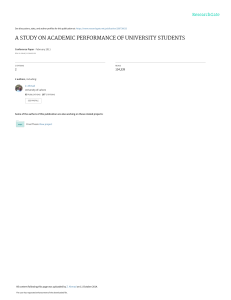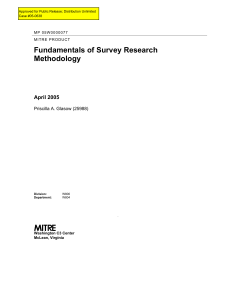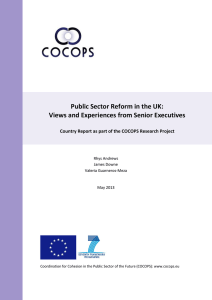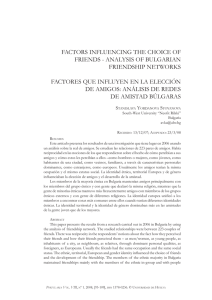Systemic Risk Survey Results – 2014 H2
Anuncio
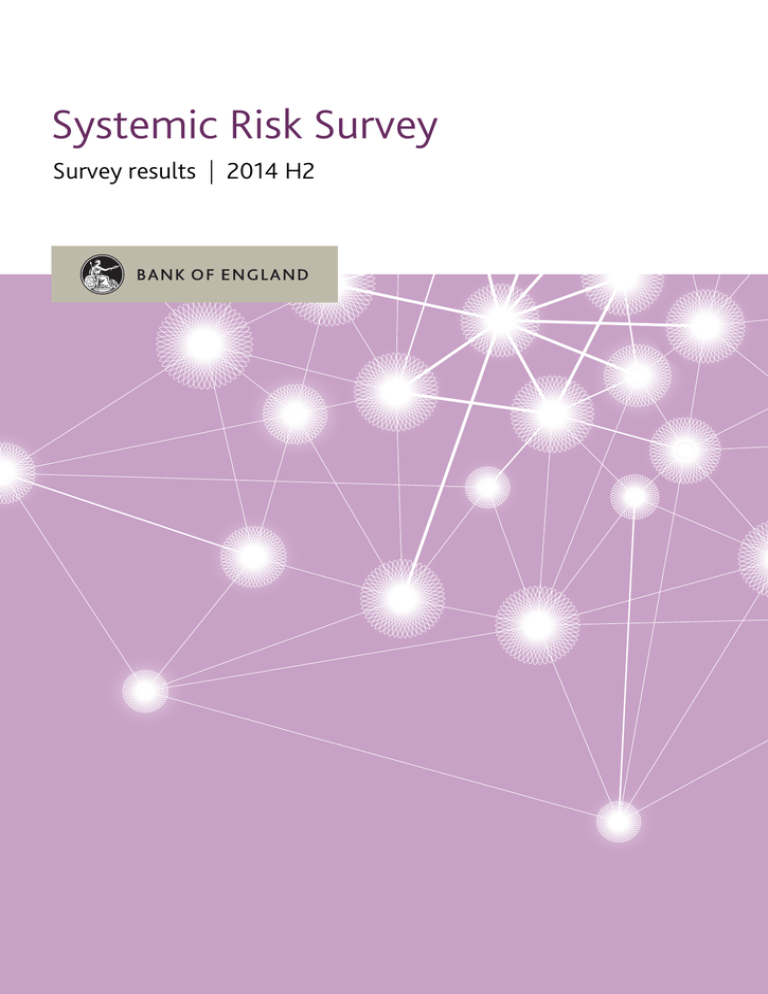
Systemic Risk Survey Survey results | 2014 H2 Systemic Risk Survey Survey results | 2014 H2 The Systemic Risk Survey • The Systemic Risk Survey is conducted by the Bank of England on a biannual basis to quantify and track market participants’ views of risks to, and their confidence in, the UK financial system. • This report presents the results of the 2014 H2 survey, which was conducted between 22 September and 22 October. Probability of a high-impact event and confidence in the UK financial system • The perceived probabilities of a high-impact event in the UK financial system over both the short and medium term have increased, ending the downward trend since 2011 H2. 8% (+5 percentage points since the 2014 H1 survey) of respondents now consider the probability high or very high over the next year, 21% (+8 percentage points) between one and three years ahead. • However, confidence in the UK financial system has continued its upward trend. This has been driven by an increase in respondents who were very confident (36%, +13 percentage points since 2014 H1) rather than fairly confident (58%, -12 percentage points). Key risks to the UK financial system • The two main risks to the UK financial system identified by respondents remain geopolitical risk (mentioned by 66% of respondents, +9 percentage points since 2014 H1) and the risk of an economic downturn (64%, +3 percentage points) with the former now the most cited risk. These are also the two most frequently cited number one risks. Responses on geopolitical risk focus mostly on the Russian/Ukrainian conflict and, to a somewhat lesser extent, on the Middle East/ISIS. • Perceived risks from regulation have ticked up slightly (+2 percentage points to 37%) while the risk of property price falls (36%, -5 percentage points) has fallen back to its level a year ago, ending an upward trend since the 2012 H2 survey. Concerns over sovereign risk (34%, -6 percentage points) continued to decrease for the fourth survey in succession and most often relate to concerns about the future of the euro area. Other top risks include those arising from the low interest rate environment (cited by 33% of respondents, down 6 percentage points since 2014 H1) and operational risk (29%, unchanged since 2014 H1). UK political risk, although still outside of the top seven most cited risks, also increased in prominence, in line with the electoral cycle (25%, +11 percentage points). Risks most challenging to manage as a firm • Six of the top seven key risks were also those listed as the most challenging to manage as a firm, but with a different ordering. Geopolitical risk continues to be the risk category most widely cited as challenging to manage. The Systemic Risk Survey is a biannual survey that asks market participants about perceived risks to, and their confidence in, the UK financial system. The survey is generally completed by executives responsible for firms’ risk management activities. This report presents the results of the 2014 H2 survey, which was conducted by the Bank of England in the period between 22 September and 22 October 2014. The results presented are based on responses to the survey and do not necessarily reflect the Bank of England’s views on risks to the UK financial system. Seventy-three market participants took part in the survey, representing a 97% response rate. Participants ranged from hedge funds, banks, building societies, large complex financial institutions, asset managers and insurers. Summary statistics are calculated by giving equal weight to each survey response. This report is available on the Bank’s website at www.bankofengland.co.uk/publications/Pages/other/srs/default. aspx. Additional background information on the survey is available in the 2009 Q3 Quarterly Bulletin article ‘Bank of England Systemic Risk Survey’ available at www.bankofengland.co.uk/ publications/Documents/quarterlybulletin/qb090305.pdf. Systemic Risk Survey 2014 H2 2 Systemic Risk Survey Introduction As part of its statutory objective to protect and enhance financial stability in the United Kingdom, the Bank works to identify risks to the stability of the UK financial system. The Systemic Risk Survey contributes to this activity by quantifying and tracking, on a biannual basis, market participants’ perceptions of such risks.(1) The survey is typically completed by executives responsible for risk management at institutions including UK banks and building societies, large foreign banks, asset managers, hedge funds and insurers. Seventy-three participants took part in the 2014 H2 survey between 22 September and 22 October 2014, representing a 97% response rate (Chart 1). This report describes the results. the percentage of respondents considering the risk to be high or very high (from 3% to 8%) and a corresponding decline in those judging the risk as low or very low (from 64% to 59%) since the 2014 H1 survey. In the medium term, a similar but somewhat larger movement can be noticed. And slightly more respondents consider the risk high or very high (21%, +8 percentage points since H1) than those judging it as low or very low (19%, -9 percentage points since H1). Chart 2 reflects these responses by weighting the probabilities into one measure. Chart 2 Probability of a high-impact event in the UK financial system(a) Very high Low High Very low Net Net percentage balances Short term 40 Medium term 30 Chart 1 Survey response rates(a)(b) Number of respondents (left-hand scale) Response rate (right-hand scale) 20 Number of respondents Per cent 10 100 + 90 90 – 80 80 70 70 60 60 50 50 40 40 30 30 100 0 10 20 09 10 11 12 13 14 2008 H1 H2 H1 H2 H1 H2 H1 H2 H1 H2 H1 H2 2008 H1 H2 H1 H2 H1 H2 H1 H2 H1 H2 H1 H2 30 09 10 11 12 13 40 14 Sources: Bank of England Systemic Risk Surveys and Bank calculations. 20 20 10 10 0 2008 H1 H2 09 H1 H2 10 H1 H2 11 H1 H2 12 H1 H2 13 H1 H2 14 0 (a) Respondents were asked for the probability of a high-impact event in the UK financial system in the short and medium term. From the 2009 H2 survey onwards, short term was defined as 0–12 months and medium term as 1–3 years. The net percentage balance is calculated by weighting responses as follows: very high (1), high (0.5), medium (0), low (-0.5) and very low (-1). Bars show the contribution of each component to the net percentage balance. Sources: Bank of England Systemic Risk Surveys and Bank calculations. (a) The percentage and number of contacts that answered at least one question in the Systemic Risk Survey. (b) Surveys from 2010 H1 onwards were carried out by the Bank. Earlier surveys were carried out by British Market Research Bureau (BMRB) on behalf of the Bank. Probability of a high-impact event Respondents were asked for their view on the probability of a high-impact event in the UK financial system in the short and medium term, and how those probabilities had changed over the past six months.(2) In the 2014 H2 survey, the perceived probabilities of a high-impact event in the UK financial system over both the short and medium term have increased, ending the downward trend since 2011 H2. In the short term, there has been a rise in These results concur with respondents’ views on how the probability of a high-impact event has changed over the past six months. For the first time since 2012 H1, in both the short and medium term, more respondents thought that the probability of a high-impact event has increased rather than decreased over the past six months. (1) The Systemic Risk Survey has been undertaken biannually since 2009, following a pilot survey conducted in July 2008. It was published for the first time in November 2011. The survey results complement other sources of information used by the Bank to identify system wide risks. (2) Since the 2009 H2 survey, short and medium term have been specifically identified as 0–12 months and 1–3 years respectively. These terms were not explicitly defined in earlier surveys. Systemic Risk Survey 2014 H2 Confidence in the UK financial system Confidence in the UK financial system has continued its upward trend since 2011 H2. This has been driven by an increase in respondents who were very confident (36%, +13 percentage points since 2014 H1) rather than fairly confident (58%, -12 percentage points). Chart 3 reflects these responses by weighting the probabilities into one measure. This result is slightly more positive than how respondents thought their confidence had changed over the past six months: a net balance of 5% of respondents noted that their confidence had increased over the past six months (15% increased, 10% decreased). Chart 3 Confidence in the stability of the UK financial system as a whole over the next three years(a) Complete confidence No confidence Very confident Net Not very confident Net percentage balances 20 15 10 5 + 3 in Table A2 in the data appendix to give an overview of the results.(1) The seven risks most frequently cited in the 2014 H2 survey were (Chart 4): • • • • • • • Geopolitical risk (cited by 66% of respondents) Risk of an economic downturn (64%) Risks around regulation/taxes (37%) Risk of property price falls (36%) Sovereign risk (34%) Risks surrounding the low interest rate environment (33%) Operational risk (29%) The top seven risks are identical to those in the 2014 H1 survey. Outside of the top seven, UK political risk and ‘Other’ have increased while household/corporate credit risk decreased in prominence. Specific responses on UK political risk referred to risks around the possibility of a UK exit from the EU and to uncertainty/risks around the result of the general election in 2015. The growth in the ‘Other’ category is due to responses citing the Ebola outbreak and the possibility of terrorist attacks in the United Kingdom or in New York, for example. 0 – 5 Chart 4 Key risks to the UK financial system(a)(b) 10 15 20 2008 H1 H2 09 H1 H2 10 H1 H2 11 H1 H2 12 H1 H2 13 Geopolitical risk Economic downturn Regulation/taxes Property price falls Sovereign risk Risk around low interest rates Operational risk Per cent H1 H2 14 100 Sources: Bank of England Systemic Risk Surveys and Bank calculations. 80 (a) Respondents were asked how much confidence they had in the stability of the UK financial system as a whole over the next three years. The net percentage balance is calculated by weighting responses as follows: complete confidence (1), very confident (0.5), fairly confident (0), not very confident (-0.5) and no confidence (-1). Bars show the contribution of each component to the net percentage balance. 60 40 There may be several possible explanations for the combination of rising confidence in the UK financial system and respondents’ perception that the probability of a high-impact event in the United Kingdom has increased. For example, respondents may judge that although a high-impact event is more likely, the United Kingdom is well equipped to deal with the consequences. Alternatively, there may be some ambiguity about the definition of a high-impact event, with respondents’ confidence being determined more by the probability of very high-impact events, which may not have increased. 20 0 2008 H1 H2 09 H1 H2 10 H1 H2 11 H1 H2 12 H1 H2 13 H1 H2 14 Sources: Bank of England Systemic Risk Surveys and Bank calculations. (a) Respondents were asked to list the five risks they thought would have the greatest impact on the UK financial system if they were to materialise. Answers were in a free format and were coded into categories after the questionnaires had been submitted; only one category was selected for each answer. Chart figures are the percentages of respondents citing a given risk at least once, among respondents citing at least one key risk. The chart shows the top seven categories; see the data appendix for additional categories. (b) Risks cited in previous surveys have been regrouped into the categories used to describe the latest data. Key risks to the UK financial system Turning to specific sources of risk to the UK financial system, respondents were asked to list the five risks they thought would have the greatest impact on the UK financial system if they were to materialise. Answers were provided in free-text format, but have been grouped into the 20 categories shown (1) These summary categories are adjusted over time in order to better capture current risks; risks cited in previous surveys have been regrouped into the new categories to ensure comparability across survey rounds. 4 Systemic Risk Survey 2014 H2 The top two risks — geopolitical risk and risk of an economic downturn — were also those cited as having the greatest potential impact (ie respondents’ number one risk) (Chart 5): including excessive, unpredictable, or poorly considered regulation, as well as on loss of confidence in regulation. • Risk of an economic downturn (22% of respondents viewed it as their number one risk) • Geopolitical risk (21%) • Sovereign risk (11%) • Risks surrounding the low interest rate environment (8%) • Inflation risk (7%) • UK political risk (5%) • Operational risk (5%) Chart 5 Number one key risks to the UK financial system(a)(b) Economic downturn Geopolitical risk Sovereign risk Risk around low interest rates Concerns over sovereign risk continued to decrease for the fourth survey in succession. The overwhelming majority (87%) of those mentioning a specific region in this regard cited the EU/euro area. Risks most challenging to manage as a firm Respondents were also asked which three of the key risks they had listed would be most challenging to manage as a firm. Chart 6 presents the seven most cited risks, which remain the same ones as in the previous survey. Inflation risk UK political risk Operational risk Per cent The perceived risk of property price falls fell back to its level seen in October 2013, ending an upward trend since the 2012 H2 survey. All but one of the responses that specified a sector mentioned residential rather than commercial property prices. 80 Chart 6 Risks most challenging to manage as a firm(a)(b) 60 Geopolitical risk Economic downturn Sovereign risk Regulation/taxes Risk around low interest rates Operational risk Financial market disruption Per cent 40 100 80 20 60 0 2008 H1 H2 09 H1 H2 10 H1 H2 11 H1 H2 12 H1 H2 13 H1 H2 40 14 Sources: Bank of England Systemic Risk Surveys and Bank calculations. (a) Respondents were asked to list the five risks they thought would have the greatest impact on the UK financial system if they were to materialise, in order of potential impact (ie greatest impact first). Answers were in a free format and were coded into categories after the questionnaires had been submitted; only one category was selected for each answer. Chart figures are the percentages of respondents citing a given risk as their number one key risk, among respondents citing at least one key risk. The chart shows the top seven categories; see the data appendix for additional categories. (b) Risks cited in previous surveys have been regrouped into the categories used to describe the latest data. Continuing its upward trend, geopolitical risk is the most cited risk in this survey and is increasingly cited by respondents as their number one risk. Most (72%) responses that cited a specific region mentioned the Russian/Ukrainian conflict and many (36%) pointed to the Middle East and ISIS. Although risk of an economic downturn is no longer the most cited risk, there has been a slight increase in the number of respondents mentioning it and it is the most cited number one risk. Within that, risks to the global and UK economic outlooks are both prominent, cited in 46% and 34% respectively. And 16% of respondents referred to Europe/euro area. Perceived risks around regulation/taxes have ticked up slightly. As in previous surveys, respondents’ focus was on regulation, 20 0 2008 H1 H2 09 H1 H2 10 H1 H2 11 H1 H2 12 H1 H2 13 H1 H2 14 Sources: Bank of England Systemic Risk Surveys and Bank calculations. (a) After respondents had listed the five risks they believed would have the greatest impact on the UK financial system if they were to materialise, they were asked which three of these risks they would find most challenging to manage as a firm. Answers were in a free format and were coded into categories after the questionnaires had been submitted; only one category was selected for each answer. Chart figures are the percentages of respondents citing a given risk at least once, among respondents citing at least one key risk. The chart shows the top seven categories only; see the data appendix for additional categories. (b) Risks cited in previous surveys have been regrouped into the categories used to describe the latest data. Respondents indicated they would find six of the seven risks from Chart 4 the most challenging to manage. Risks around property prices do not appear in the top seven, perhaps indicating that they are easier for firms to manage: • • • • • • • Geopolitical risk (48% of respondents) Risk of an economic downturn (29%) Sovereign risk (26%) Risks around regulation/taxes (26%) Risks surrounding the low interest rate environment (17%) Operational risk (17%) Risk of financial market disruption (13%). Systemic Risk Survey 2014 H2 5 Data appendix The tables in this appendix in Excel format and the survey questionnaire are available on the Bank’s website at www.bankofengland.co.uk/publications/Pages/other/srs/default.aspx. Table A1: Aggregate risks to the UK financial system(a)(b) 2008 2009 2010 H1 H2 2011 H1 2012 H2 H1 2013 H2 H1 2014 H2 H1 H2 0 Probability of a high-impact event in the UK financial system in the short term(c) Very high 9 3 2 0 18 3 1 0 1 0 High 36 29 15 15 37 33 19 8 5 3 8 Medium 42 53 45 50 43 40 46 42 38 33 33 Low 12 15 34 35 3 23 34 46 50 53 51 0 0 5 0 0 1 0 4 5 11 8 Very low Probability of a high-impact event in the UK financial system in the medium term(c) Very high 0 3 6 9 16 7 8 1 1 0 3 High 30 38 25 28 44 41 33 22 22 13 18 Medium 67 56 57 56 34 44 51 63 61 60 60 Low 3 3 12 6 6 7 9 13 14 28 19 Very low 0 0 0 1 0 1 0 0 1 0 0 Change in the probability over the past six months of a high-impact event in the UK financial system in the short term(d) Increased 55 18 15 26 88 27 11 7 5 6 27 Unchanged 24 24 57 57 10 48 54 54 39 49 59 Decreased 21 59 28 16 1 25 34 39 55 46 14 Change in the probability over the past six months of a high-impact event in the UK financial system in the medium term(d) Increased 64 15 23 21 69 29 11 12 14 14 34 Unchanged 33 53 55 66 29 60 72 62 51 61 53 Decreased 3 32 22 13 1 11 16 26 34 25 12 Confidence in the stability of the UK financial system as a whole over the next three years(e) 0 0 0 1 0 1 3 3 3 1 0 Very confident Complete confidence 36 15 12 12 15 12 13 14 16 22 36 Fairly confident 58 61 68 78 76 57 64 71 70 78 69 Not very confident 3 18 9 10 28 22 14 13 4 7 7 No confidence 0 0 0 0 0 0 0 0 0 0 0 Change in confidence over the past six months(f) Increased 25 10 3 12 11 22 33 25 15 Unchanged 65 79 35 77 81 67 62 68 75 Decreased 11 10 62 11 8 11 5 7 10 Sources: Bank of England Systemic Risk Surveys and Bank calculations. (a) Entries are percentages of respondents and may not sum to 100% due to rounding. (b) The survey has been undertaken biannually since 2009, following a pilot survey conducted in July 2008. Due to insufficient space in this table, 2009 H2 and 2010 H1 results have not been included. (c) Respondents were asked what the probability of a high-impact event in the UK financial system was in their view, for both the short and medium term. In the 2009 H2–2014 H2 surveys, short term was defined as 0–12 months and medium term as 1–3 years. (d) Respondents were asked how the probability had changed over the past six months for the short and medium term. In the 2009 H2–2014 H2 surveys, short term was defined as 0–12 months and medium term as 1–3 years. (e) Respondents were asked how much confidence they had in the stability of the UK financial system as a whole over the next three years. (f) Respondents were asked how their confidence had changed over the past six months. The question was asked from 2010 H1 onwards. Systemic Risk Survey 2014 H2 6 Table A2: Key risks to the UK financial system(a)(b) 2008 2009 2010 H1 H2 2011 H1 2012 H2 H1 2013 H2 H1 2014 H2 H1 H2 Key risks(c) Geopolitical risk 3 6 5 7 3 10 11 5 13 57 66 36 61 83 69 76 79 77 79 67 61 64 Risks around regulation/taxes 27 33 45 32 38 40 34 39 41 35 37 Risk of property price falls 45 24 41 31 16 21 14 25 36 40 36 Sovereign risk 9 21 41 66 76 79 94 76 74 40 34 Risk surrounding the low interest rate environment(d) 6 3 3 4 1 4 9 26 43 39 33 Operational risk 21 18 17 15 10 12 14 24 25 29 29 UK political risk 0 0 8 6 1 3 5 4 5 14 25 Risk of financial market disruption/dislocation 45 24 27 31 19 21 22 20 18 18 18 Risk of infrastructure disruption 12 9 9 6 10 10 9 11 11 14 18 Risk of financial institution failure/distress 85 33 17 18 26 25 25 26 30 22 16 6 0 6 7 0 5 4 5 8 15 16 12 9 9 3 7 1 1 9 13 8 15 6 9 9 19 6 5 5 7 7 6 11 15 24 13 13 12 16 16 14 8 4 8 Household/corporate credit risk 12 36 19 25 10 14 14 18 11 19 7 Funding risk 18 33 39 43 57 45 32 17 16 14 4 Risk of an economic downturn Risks surrounding monetary and fiscal policy Other Inflation risk Risk of tightening in credit conditions Risk of loss of confidence in the authorities 3 9 6 7 10 15 11 11 9 4 3 Risks around public anger against, or distrust of, financial institutions 0 0 0 1 0 0 10 1 1 4 3 12 18 2 4 4 4 1 0 0 0 1 Risk of lack of confidence in ratings, valuations and disclosure Number one key risks(e) 15 24 48 36 13 16 14 32 25 22 22 Geopolitical risk Risk of an economic downturn 0 3 2 4 1 1 0 0 0 13 21 Sovereign risk 0 15 9 36 62 60 68 38 39 19 11 Risk surrounding the low interest rate environment(d) 0 0 0 0 0 0 1 9 9 11 8 Inflation risk 0 0 2 1 0 1 0 0 0 1 7 UK political risk 0 0 0 0 0 0 0 3 1 3 5 Operational risk 0 3 0 1 0 0 0 1 0 0 5 Risks around regulation/taxes 3 3 5 1 1 3 3 3 8 7 4 12 3 3 3 4 3 0 3 1 1 4 Other 0 0 5 0 0 0 0 0 1 1 4 Risk of property price falls 6 3 2 3 1 3 1 3 7 8 3 55 12 5 4 1 4 3 4 3 1 3 Risk of infrastructure disruption 0 0 2 0 1 0 1 3 1 1 1 Risk of tightening in credit conditions 3 0 2 0 0 0 0 0 0 0 1 Risks surrounding monetary and fiscal policy 0 0 2 0 0 1 1 1 0 7 0 0 Risk of financial market disruption/dislocation Risk of financial institution failure/distress Funding risk 6 12 13 9 7 5 4 0 1 1 Household/corporate credit risk 0 15 2 0 0 0 0 0 0 1 0 Risk of loss of confidence in the authorities 0 3 2 0 6 1 4 1 3 0 0 Risk of lack of confidence in ratings, valuations and disclosure 0 3 0 0 0 0 0 0 0 0 0 Risks around public anger against, or distrust of, financial institutions 0 0 0 0 0 0 0 0 0 0 0 33 33 64 68 68 73 79 76 76 72 73 Number of respondents citing at least one key risk Sources: Bank of England Systemic Risk Surveys and Bank calculations. (a) Respondents were asked which five risks they believed would have the greatest impact on the UK financial system if they were to materialise, in order of potential impact (ie greatest impact first). Answers were provided in a free format and were subsequently coded into the above categories; only one category was selected for each answer. Risks cited in previous surveys have been regrouped into the categories used to describe the latest data. (b) The survey has been undertaken biannually since 2009, following a pilot survey conducted in July 2008. Due to insufficient space in this table, 2009 H2 and 2010 H1 results have not been included. (c) Percentages of respondents citing each risk at least once in their top five, among those citing at least one risk. (d) The definition of this risk includes risks associated with a snapback in low rates to more normal levels, as well as risks directly associated with low rates. (e) Percentages of respondents citing each risk as their number one risk (ie the risk with the greatest potential impact), among those citing at least one key risk. Systemic Risk Survey 2014 H2 7 Table A3: Risks most challenging to manage as a firm(a)(b) 2008 2009 2010 H1 Geopolitical risk H2 2011 H1 2012 H2 H1 2013 H2 H1 2014 H2 H1 H2 48 0 0 2 4 0 6 5 3 3 36 33 33 50 40 38 39 41 42 33 27 29 Sovereign risk 0 6 31 44 68 69 78 63 56 33 26 Risks around regulation/taxes 9 30 30 28 31 32 24 34 29 26 26 Risk surrounding the low interest rate environment(c) 3 3 2 0 1 4 6 21 23 23 17 Risk of an economic downturn Operational risk 15 3 5 10 7 10 8 14 16 17 17 Risk of financial market disruption/dislocation 27 6 16 19 12 14 15 15 14 14 13 Risk of infrastructure disruption 6 6 6 4 6 7 6 8 10 11 13 Other 6 3 6 3 3 0 1 3 5 7 12 UK political risk 0 0 2 1 0 1 1 4 4 6 12 Risk of financial institution failure/distress 48 18 16 12 21 15 17 14 14 13 9 Risk of property price falls 18 6 8 4 0 4 3 10 14 11 7 0 0 6 4 3 1 3 5 1 3 7 Inflation risk Risks surrounding monetary and fiscal policy 3 0 3 1 0 4 4 3 5 9 6 Household/corporate credit risk 6 18 8 12 3 4 6 8 3 7 6 18 15 27 25 35 23 18 7 7 11 3 Risk of loss of confidence in the authorities 0 3 3 6 7 8 8 4 7 4 1 Risk of tightening in credit conditions 6 3 3 6 0 7 1 5 4 1 1 Risk of lack of confidence in ratings, valuations and disclosure 6 9 2 3 3 0 0 0 0 0 1 Risks around public anger against, or distrust of, financial institutions 0 0 0 1 0 0 3 0 1 0 0 Cited at least one key risk, but did not cite any risk as challenging to manage (per cent) 0 3 2 0 0 3 1 4 4 3 5 33 33 64 68 68 73 79 76 76 72 73 Funding risk Number of respondents citing at least one key risk Sources: Bank of England Systemic Risk Surveys and Bank calculations. (a) After respondents had listed the five risks they believed would have the greatest impact on the UK financial system if they were to materialise, they were asked which three of these risks they would find most challenging to manage as a firm. Answers were provided in a free format and were subsequently coded into the above categories; only one category was selected for each answer. Risks cited in previous surveys have been regrouped into the categories used to describe the latest data. Table entries are the percentages of respondents citing each risk at least once in this second question, among those citing at least one key risk. (b) The survey has been undertaken biannually since 2009, following a pilot survey conducted in July 2008. Due to insufficient space in this table, 2009 H2 and 2010 H1 results have not been included. (c) The definition of this risk includes risks associated with a snapback in low rates to more normal levels, as well as risks directly associated with low rates. © Bank of England 2014 ISSN: 2048-7800 (online)
